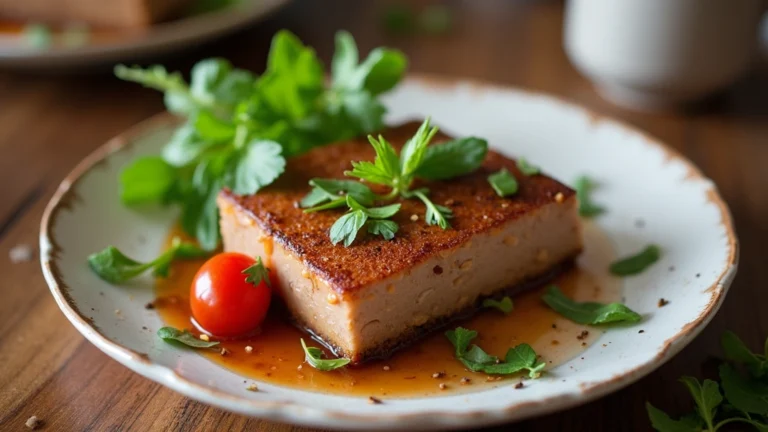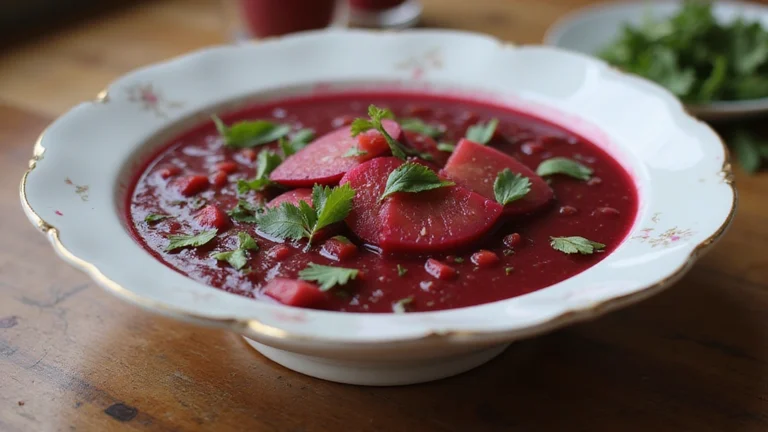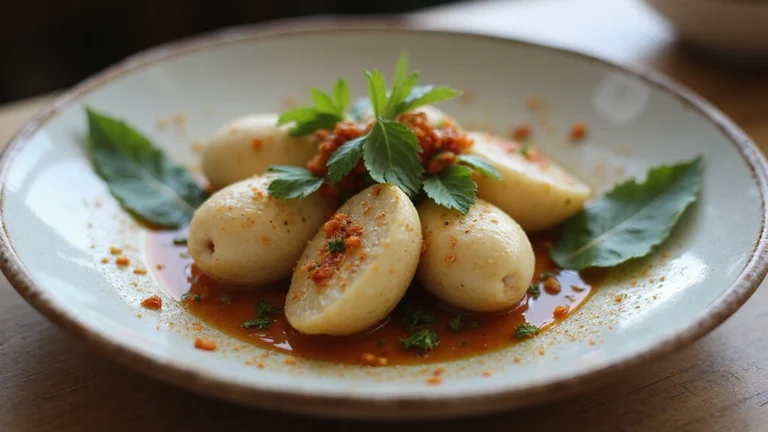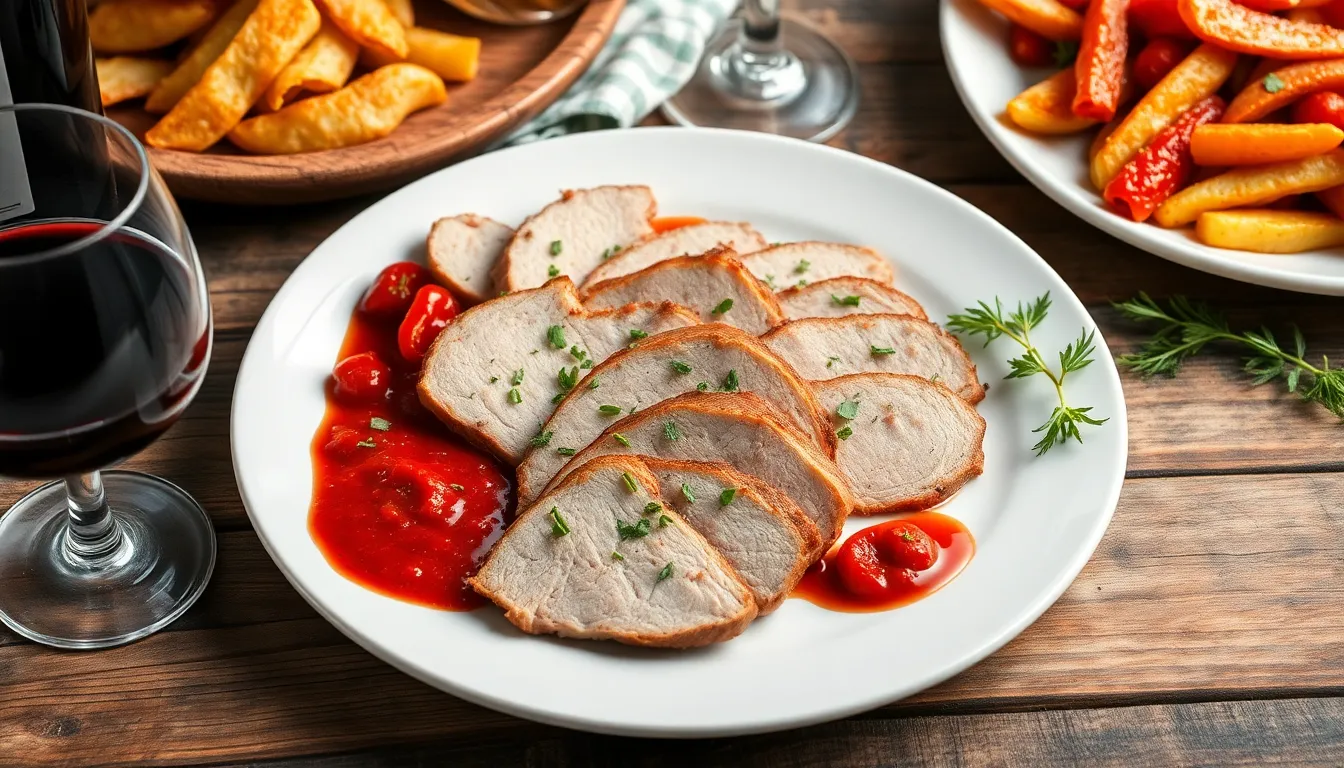
Looking for the perfect Spanish pork loin recipe that’ll transport your taste buds straight to the sunny Mediterranean? This traditional Spanish delicacy combines simple ingredients with bold flavors for a meal that’ll impress everyone at your dinner table.
Spanish pork loin, or “lomo de cerdo,” is a centerpiece of authentic Spanish cuisine that showcases the country’s love for simple yet flavorful dishes. This succulent cut of meat is typically marinated in olive oil, garlic, and paprika before being roasted to perfection. The result is a tender, juicy main course that pairs beautifully with a glass of Spanish red wine.
You’ll find this dish in homes and restaurants throughout Spain, from Barcelona to Madrid. What makes Spanish pork loin special is its versatility – serve it warm as your main entrée or cold as part of a tapas spread. With just a handful of ingredients and minimal prep time, you’ll create a memorable meal that brings a taste of Spain to your kitchen.
What is Spanish Pork Loin?
Spanish pork loin or “lomo de cerdo” serves as a cornerstone of traditional Spanish cuisine with its distinctive preparation and flavor profile. The dish features tender cuts of pork loin marinated in a robust mixture of olive oil garlic paprika and herbs that penetrate deep into the meat.
Unlike American preparations that often rely on sweet glazes or barbecue sauces Spanish pork loin embraces Mediterranean flavors with its emphasis on olive oil herbs and spices. Regions across Spain prepare this dish differently with variations from Andalusia featuring more paprika while Catalonian versions might incorporate more garlic and herbs.
Traditionally Spanish chefs select center-cut pork loin for its ideal balance of lean meat and just enough fat to keep the dish moist during cooking. The meat typically undergoes a lengthy marination period ranging from 4 hours to overnight allowing the flavors to fully develop and tenderize the pork.
Spanish pork loin appears on menus throughout Spain from family-run tapas bars to upscale restaurants highlighting its versatility and cultural significance. The dish can be served hot as a main course sliced thinly for sandwiches or chilled and presented as part of a charcuterie board making it ideal for various dining occasions.
What distinguishes authentic Spanish pork loin is the cooking technique which often involves searing the meat to lock in juices before finishing it at a lower temperature. This method ensures the pork remains juicy inside while developing a flavorful crust on the exterior seasoned with the signature spices of Spanish cuisine.
Why You’ll Love This Spanish Pork Loin Recipe

This Spanish pork loin recipe combines remarkable simplicity with incredible depth of flavor. You’ll appreciate how straightforward the preparation is—just coat your pork loin with a vibrant mixture of spices centered around sweet and hot paprika garlic and kosher salt before roasting it to perfection. The rustic cooking method ensures the meat remains tender and juicy while the smoky spicy flavors penetrate beyond the surface and throughout the entire roast.
The authentic traditional roots of this dish make it especially appealing. Based on the Basque preparation known as lomo adobado this recipe brings reliable results every time without unnecessary complication. Busy weeknights become less stressful as this dish effortlessly brings an impressive dinner to your table. For those times when you need an even quicker meal the spice-rubbed pork can be sliced thickly and pan-fried like pork chops following typical Basque regional practices.
The versatility of Spanish pork loin adapts to various serving styles. Pair it with rustic bread for a simple meal or elevate it with citrus elements that complement the savory profile. Many Spanish households serve this dish with piquillo pepper sauce for added depth and complexity. The lean yet flavorful nature of pork loin makes this recipe a practical choice for both everyday dinners and special occasions.
Your guests will be impressed by the distinctive flavor profile that stands apart from typical American pork preparations. Unlike sweet glazed versions this Spanish-inspired dish highlights Mediterranean spices that create a robust earthy character unique to Iberian cuisine. The balance between accessibility and authenticity makes this recipe a true standout in your culinary repertoire.
Key Ingredients for Spanish Pork Loin
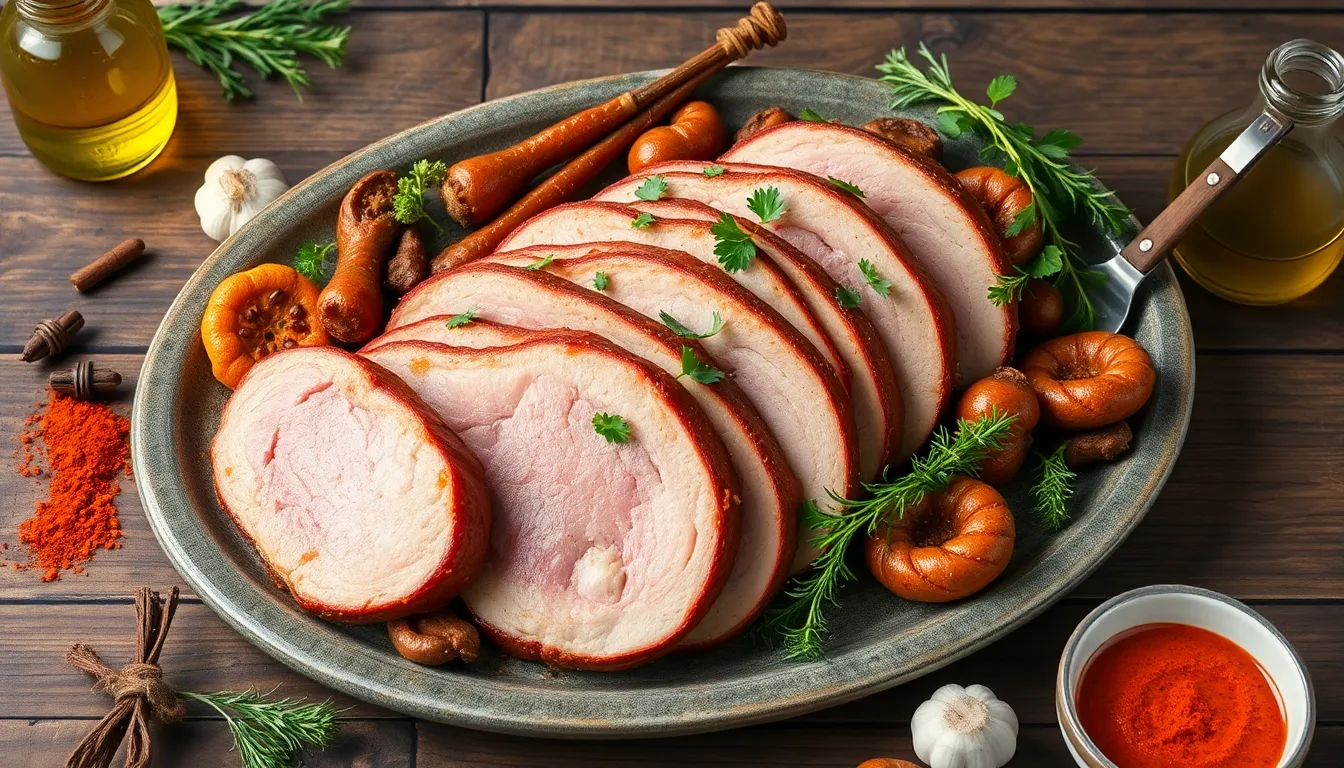
The authentic flavor of Spanish pork loin comes from a carefully selected combination of quality meat and traditional Mediterranean spices. These ingredients work together to create the distinctive smoky-savory profile that makes this dish a standout in Spanish cuisine.
Pork Loin Selection Tips
Select a pork loin with a fat cap whenever possible as this natural layer helps retain moisture and enriches flavor during the roasting process. For quicker cooking scenarios a pork tenderloin serves as an excellent alternative offering a smaller tender cut that works well for both roasting and skillet preparations. Ask your butcher for a fresh well-trimmed cut with uniform thickness to ensure even cooking throughout the roast. The quality of your pork significantly impacts the final dish so investing in a premium cut pays dividends in flavor and texture. Remember that the meat should have a pinkish-red color and minimal liquid in the packaging which indicates freshness.
Spanish Herbs and Spices
Paprika (Pimentón) stands as the cornerstone spice in authentic Spanish pork preparations with smoked paprika (pimentón ahumado) particularly prized for its distinctive depth of flavor. Fresh garlic adds essential savory notes that form the backbone of the seasoning blend. Ground coriander and cumin contribute earthy slightly citrusy undertones common in traditional Iberian seasoning mixtures. Cinnamon and black pepper provide subtle warmth and complexity that elevate the overall flavor profile. Heat elements from cayenne pepper or chili powder add dimension and sharpness characteristic of many Spanish-inspired recipes. Aromatic herbs like thyme occasionally make an appearance for additional layering of flavor. The liberal use of high-quality olive oil serves both as a flavor carrier and helps create a flavorful crust during cooking. Properly measured kosher salt remains essential for balanced seasoning as its crystal size can vary significantly between brands.
- Pork loin or tenderloin (preferably with fat cap)
- Sweet and smoked paprika
- Fresh garlic or garlic powder
- Extra virgin olive oil
- Ground coriander and cumin
- Cinnamon (small amount)
- Black pepper
- Cayenne pepper or chili powder (to taste)
- Dried thyme
- Kosher salt (properly weighed for accuracy)
Equipment Needed
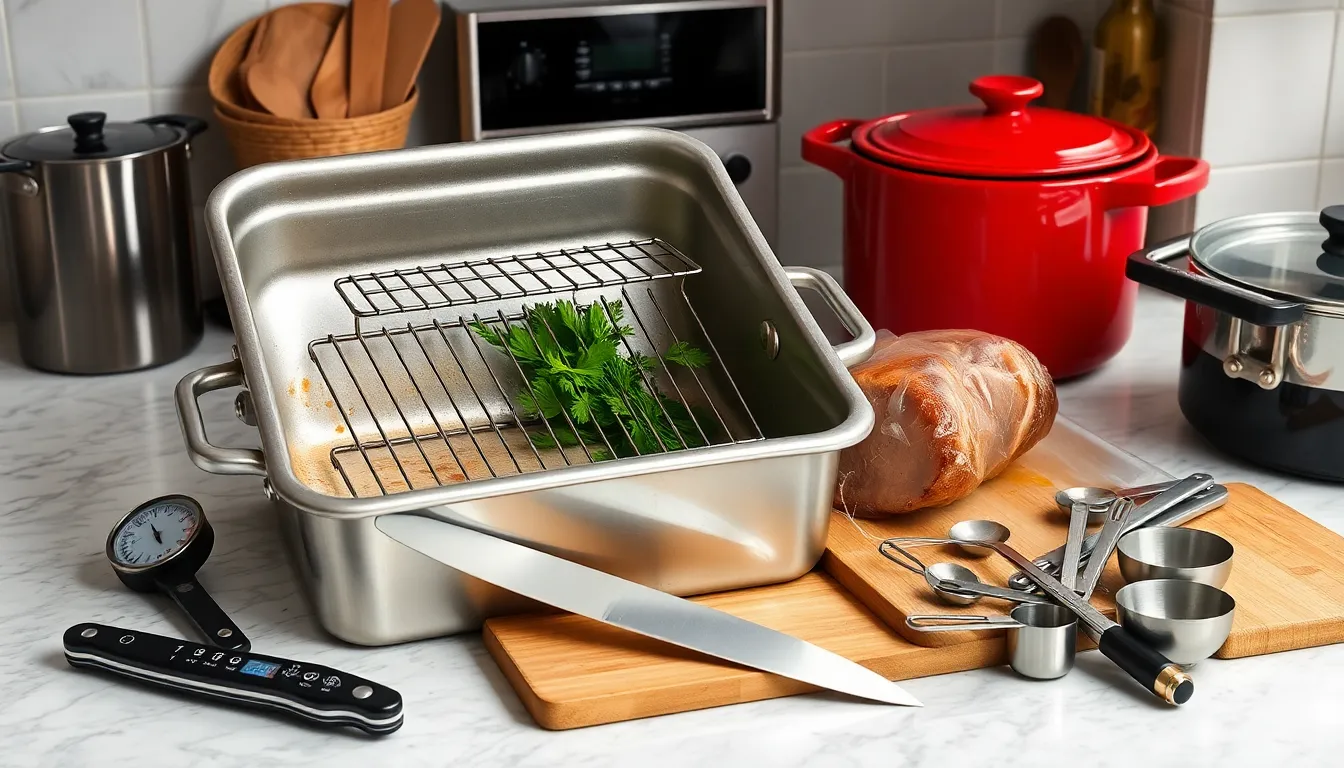
Preparing traditional Spanish pork loin requires relatively simple kitchen tools that most home cooks already have on hand. Gathering these items before you begin will streamline your cooking process and help you achieve authentic results.
For Roasting Method
- Roasting pan with wire rack – Elevates the pork to allow even heat circulation
- Meat thermometer – Essential for achieving the perfect internal temperature (145°F)
- Sharp chef’s knife – For trimming and slicing the pork loin
- Cutting board – Preferably with a juice groove to catch drippings
- Measuring spoons – For precise spice measurements
- Small mixing bowl – To combine your paprika rub ingredients
- Kitchen twine – If tying the roast for even cooking
- Aluminum foil – For tenting during rest period
For Pan-Fried Method
- Large heavy-bottomed skillet – Cast iron works exceptionally well
- Tongs – For safely turning the pork slices
- Sharp knife – To slice the pork loin into medallions
- Paper towels – To pat the meat dry before cooking
For Curing (Lomo Curado)
- Vacuum sealer – Creates the proper environment for curing
- Butcher’s twine – For hanging and shaping the loin
- Dry aging sheets – Controls humidity during the curing process
- Kitchen scale – For precise measurement of salt and spices
- Large container – For initial salt cure
For Stew Preparation
- Dutch oven or large pot – Provides even heat distribution
- Wooden spoon – For stirring without scratching your cookware
- Strainer – If making homemade stock for the stew
- Garlic press – For extracting maximum flavor from fresh garlic
- Sharp paring knife – For detailed prep of smaller ingredients
Having these tools ready ensures you can focus on the techniques that make Spanish pork loin dishes so distinctive and flavorful. The equipment needs remain straightforward regardless of which preparation method you choose, making this authentic Spanish dish accessible for home cooks of all skill levels.
Spanish Pork Loin Marinade
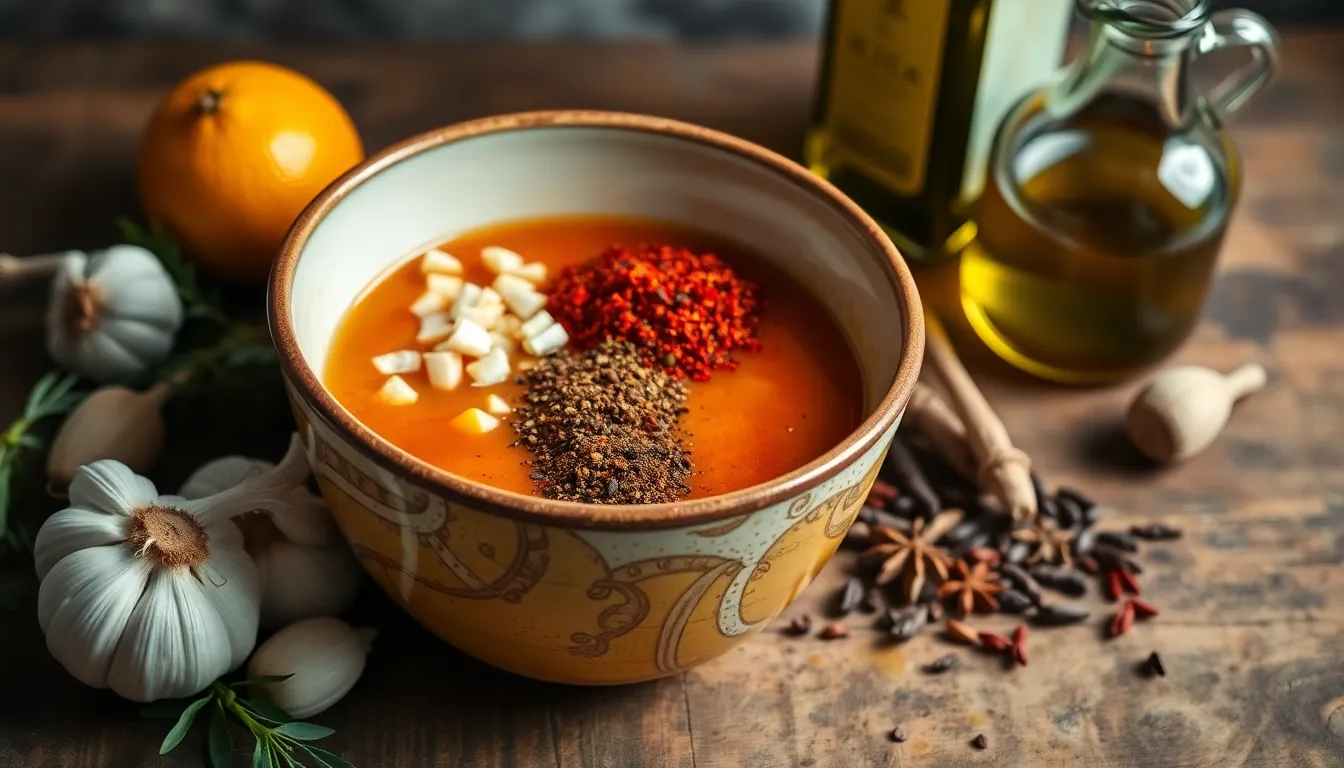
The authentic marinade for Spanish pork loin transforms a simple cut of meat into a flavor-packed delicacy with minimal effort. This traditional adobo infuses the pork with characteristic Mediterranean flavors while tenderizing the meat to ensure juicy results every time.
Marinade Ingredients
- 4 tablespoons olive oil (high-quality extra virgin recommended)
- 1 head garlic, finely chopped or minced
- 3 teaspoons smoked Spanish paprika (pimentón)
- 1 teaspoon dried oregano
- ½ teaspoon crushed red pepper flakes
- ½ teaspoon kosher salt
- 2 tablespoons orange juice or vinegar (for acidity)
- ½ teaspoon ground cumin (optional)
The foundation of this marinade lies in the combination of smoked paprika and garlic which gives Spanish pork loin its distinctive rustic flavor. Quality olive oil serves as both a flavor carrier and tenderizing agent. For an authentic touch you can add bitter orange juice or a splash of vinegar which helps break down muscle fibers while adding a subtle tangy note. Spanish chefs often include cumin and annatto for additional depth in regional variations across Spain.
Marinating Instructions
- Prepare your marinade base by combining olive oil with finely chopped garlic in a glass bowl or container large enough to hold your pork loin.
- Add dry spices including smoked paprika oregano crushed red pepper and salt then mix thoroughly until a paste-like consistency forms.
- Pour in your acidic component (orange juice or vinegar) and stir until all ingredients are well incorporated.
- Place your pork loin into the marinade ensuring it’s completely coated on all sides.
- Cover the container tightly with plastic wrap or a lid and refrigerate for at least 24 hours—ideally overnight.
- Turn the pork occasionally during marination to ensure even flavor distribution.
This lengthy marination period is essential for developing the full flavor profile of traditional Spanish pork loin. You’ll achieve best results by allowing a full 24 hours for the spices to penetrate the meat deeply. The marinade works its magic by breaking down tough proteins while infusing the distinctive smoky-savory notes that make this dish a staple in Spanish cuisine. Before cooking simply remove the pork from refrigeration and let it come to room temperature for about 30 minutes which promotes even cooking.
How to Prepare Spanish Pork Loin
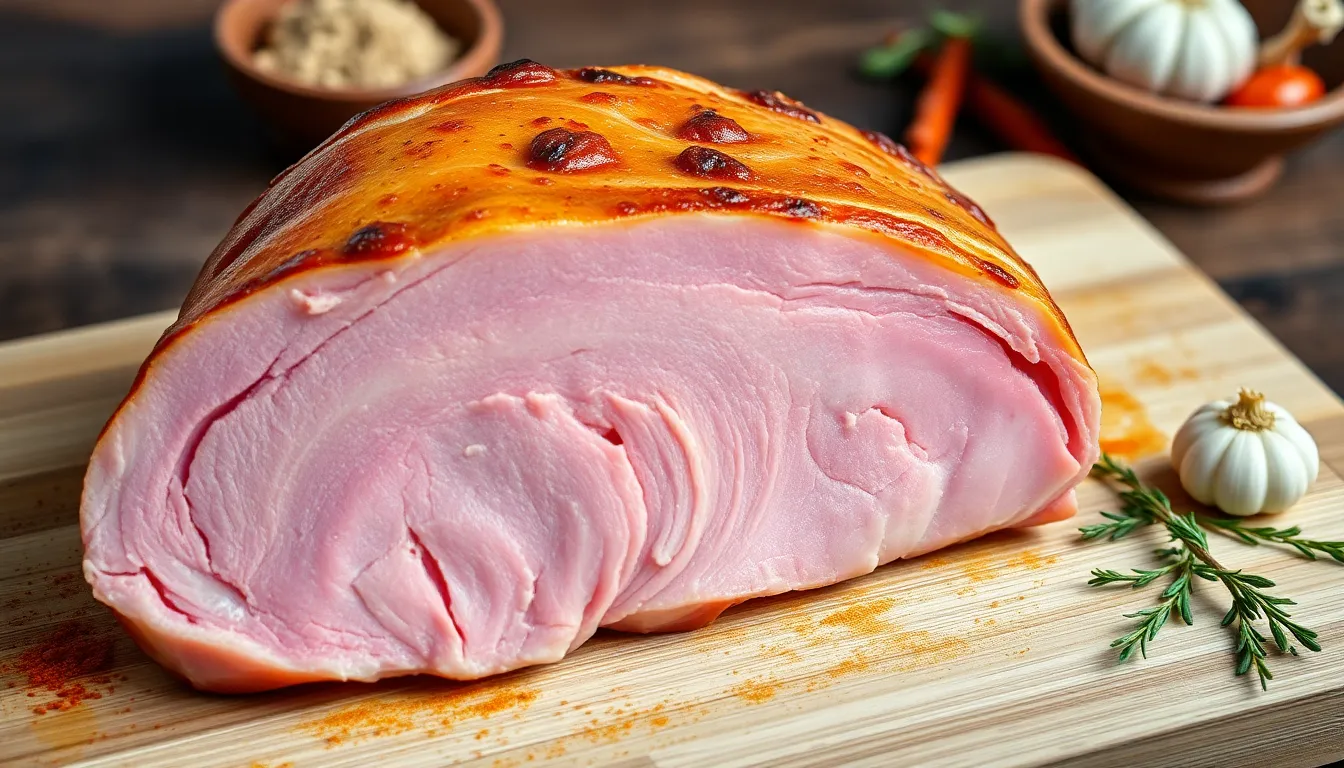
Preparing authentic Spanish pork loin involves simple techniques that highlight the meat’s natural flavor while incorporating bold Mediterranean seasonings. The process focuses on proper trimming, seasoning, and cooking methods that have been perfected throughout Spain’s culinary regions.
Trimming and Prepping the Meat
Select a pork loin with a good fat cap to ensure moisture retention during cooking. This lean cut benefits greatly from that protective layer of fat which gradually bastes the meat as it cooks. Remove any silver skin and tough connective tissue using a sharp knife, as these elements can make the final dish tough and chewy.
Maintain about ¼ inch of fat on top of the roast when possible to maximize flavor and juiciness. You can score the fat cap in a crosshatch pattern to help it render more effectively and allow seasonings to penetrate deeper into the meat.
For quick-cooking options, consider cutting the pork loin into portions based on your preferred cooking method. Thick slices work perfectly for skillet cooking while thin cuts excel when prepared “a la plancha” – the Spanish technique of quick-frying on high heat. The thickness of your cuts will determine cooking time and final texture.
Pat the meat dry with paper towels before applying any seasonings. This step ensures better adhesion of spices and promotes superior browning during the cooking process. Properly prepped pork loin serves as the perfect canvas for the distinctive Spanish flavors to follow.
Seasoning Techniques
Apply a classic Spanish spice rub to your pork loin for authentic flavor. Combine both sweet and hot smoked paprika with freshly minced garlic and kosher salt to create the base of your seasoning mixture. This combination delivers the signature smoky depth that defines Spanish pork preparations.
Enhance the complexity of your spice blend by incorporating warm spices like coriander, cumin, cinnamon, and black pepper. Fresh or dried oregano adds an herbal note while crushed red pepper flakes contribute additional heat according to your preference.
Marinate sliced pork loin for maximum flavor penetration. Create a marinade using quality olive oil, paprika, oregano, red pepper flakes, and salt, then submerge the meat for 24 hours in the refrigerator. This extended marination period transforms the pork by allowing the flavors to fully permeate the tissue.
Distribute your chosen spice rub evenly over all surfaces of the pork loin, pressing gently to adhere. For whole roasts, apply the seasoning mixture at least 30 minutes before cooking or preferably the night before to develop deeper flavor profiles. Allow the seasoned meat to rest at room temperature for 30 minutes before cooking to ensure even heat distribution and superior texture.
Cooking Methods
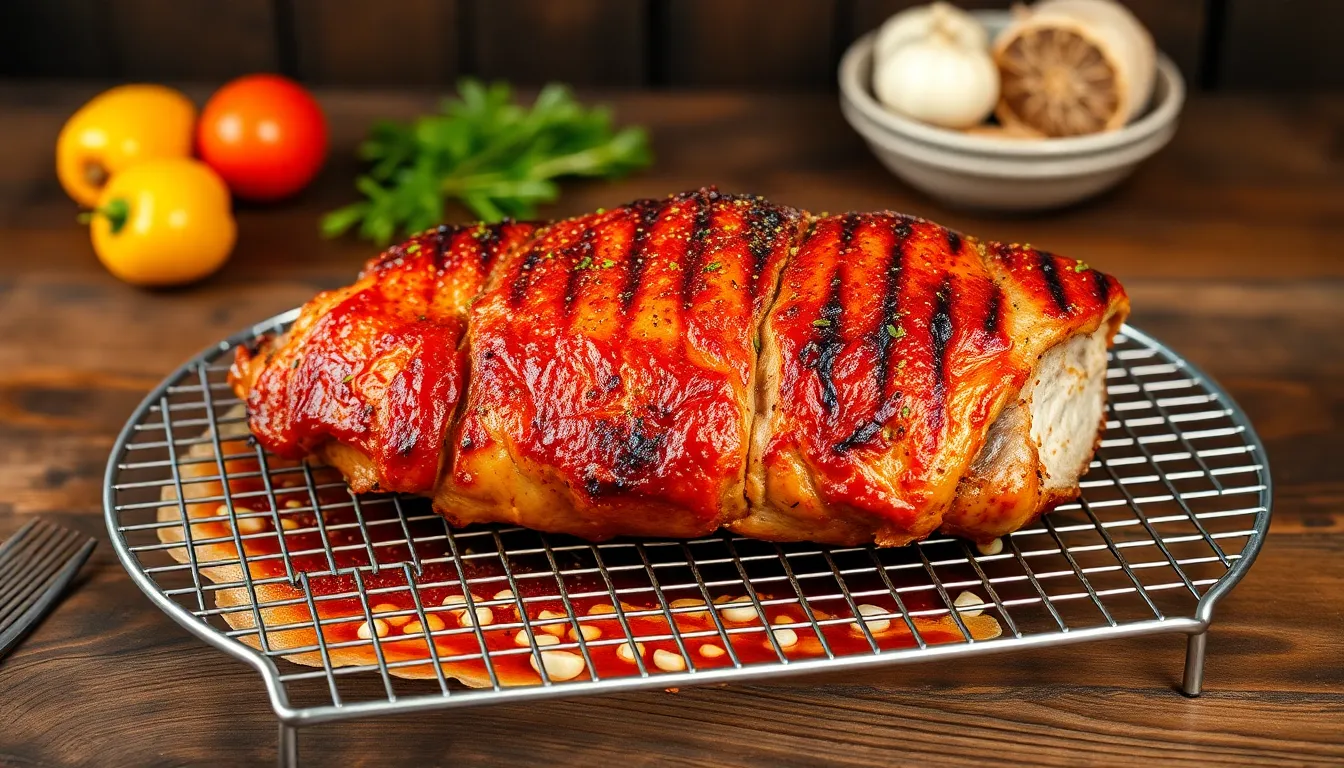
Spanish pork loin offers incredible versatility in preparation methods that bring out different aspects of its rich flavor profile. The cooking technique you choose can significantly impact the final texture and taste of this traditional dish.
Oven-Roasted Spanish Pork Loin
Roasting Spanish pork loin in the oven creates a tender interior with a beautifully seasoned exterior. Set your oven to a low temperature of 300°F (150°C) for traditional slow roasting that develops deep flavors throughout the meat. Place your seasoned pork loin on a wire rack inside a roasting pan to ensure even cooking and proper air circulation. This elevated position allows the fat to render slowly while keeping the meat moist and succulent. The slow roasting method works particularly well with paprika-seasoned pork loin as it allows the spices to gradually infuse into the meat without burning. Monitor the internal temperature with a meat thermometer until it reaches 145°F (63°C) for perfect doneness. For a quicker variation that still delivers exceptional results try roasting at a higher temperature of 450°F (232°C) for approximately 20-25 minutes after applying your spice rub containing paprika coriander cumin and cinnamon.
Grilled Spanish Pork Loin
Grilling imparts a distinctive smoky flavor that beautifully complements the paprika and garlic seasonings traditional to Spanish pork loin. Prepare your grill for direct high heat cooking which creates an appetizing sear on the exterior while keeping the interior juicy. Slice your marinated pork loin into thick chops before grilling or cook the entire tenderloin for a more dramatic presentation. The high heat of the grill caramelizes the spices and creates a crisp exterior with appealing grill marks that enhance both flavor and visual appeal. This cooking method is quicker than oven roasting and particularly popular in Spanish regional cuisines where the smokiness from the grill enhances the already robust flavors of paprika and garlic. Turn the meat occasionally to ensure even cooking and to prevent any side from becoming overly charred.
Slow Cooker Method
Slow cooking transforms Spanish pork loin into an incredibly tender dish that practically melts in your mouth. Apply your Spanish spice rub featuring paprika garlic cumin and coriander generously all over the pork loin before placing it in your slow cooker. Set the appliance to low heat and allow the pork to cook undisturbed for 6-8 hours depending on the size of your cut. This hands-off cooking method is perfect for busy days when you want to return to a fully prepared meal. The extended cooking time allows the spices to penetrate deeply into the meat creating layers of flavor impossible to achieve with quicker methods. Slow cooked Spanish pork loin pairs exceptionally well with traditional sauces such as piquillo pepper sauce which adds brightness and complexity to the rich tender meat. The resulting texture makes this preparation ideal for serving alongside rustic Spanish sides like patatas bravas or a simple green salad.
Step-by-Step Cooking Instructions

Follow these simple yet precise instructions to create an authentic Spanish pork loin that balances juicy tenderness with rich, smoky flavors. Each stage of the cooking process contributes to developing the distinctive taste profile that makes this dish a staple of Spanish cuisine.
Searing the Pork
Begin by preheating a skillet over high heat until it becomes very hot. Rub your pork loin generously with olive oil before applying a traditional Spanish spice blend consisting of smoked paprika, ground coriander, cumin, cinnamon, salt, and black pepper. Place the seasoned meat carefully into the hot skillet and sear all sides until they develop a golden-brown crust. This crucial step typically takes about 2-3 minutes per side and seals in the meat’s natural juices while creating a flavorful exterior. The caramelization that occurs during searing contributes significantly to the depth of flavor in the final dish.
Roasting to Perfection
Preheat your oven to between 325°F and 450°F depending on your preferred cooking method. Transfer the seared pork loin to a roasting pan, ideally positioning it on a rack or over a bed of vegetables for even heat circulation. For a juicier result with gentle cooking, opt for the lower temperature range (300-325°F). If you prefer a more pronounced exterior crust and faster cooking time, use the higher temperature setting (450°F). Roast the pork uncovered until its internal temperature reaches 140-145°F, which typically requires 20-40 minutes depending on the size of your loin and your chosen oven temperature. Monitor the internal temperature with a meat thermometer inserted into the thickest part of the loin for precise doneness.
Resting the Meat
Remove your perfectly roasted pork loin from the oven once it reaches the target temperature. Loosely tent the meat with aluminum foil and allow it to rest undisturbed for 5-10 minutes before slicing. This resting period permits the juices to redistribute throughout the meat fibers rather than running out when cut. The internal temperature will continue to rise slightly during this time, completing the cooking process while ensuring maximum tenderness and moisture retention. After resting, slice the pork loin into medium-thick pieces approximately ½ inch wide and serve with traditional Spanish accompaniments such as roasted potatoes, piquillo pepper sauce, or romesco sauce for an authentic dining experience.
Serving Suggestions
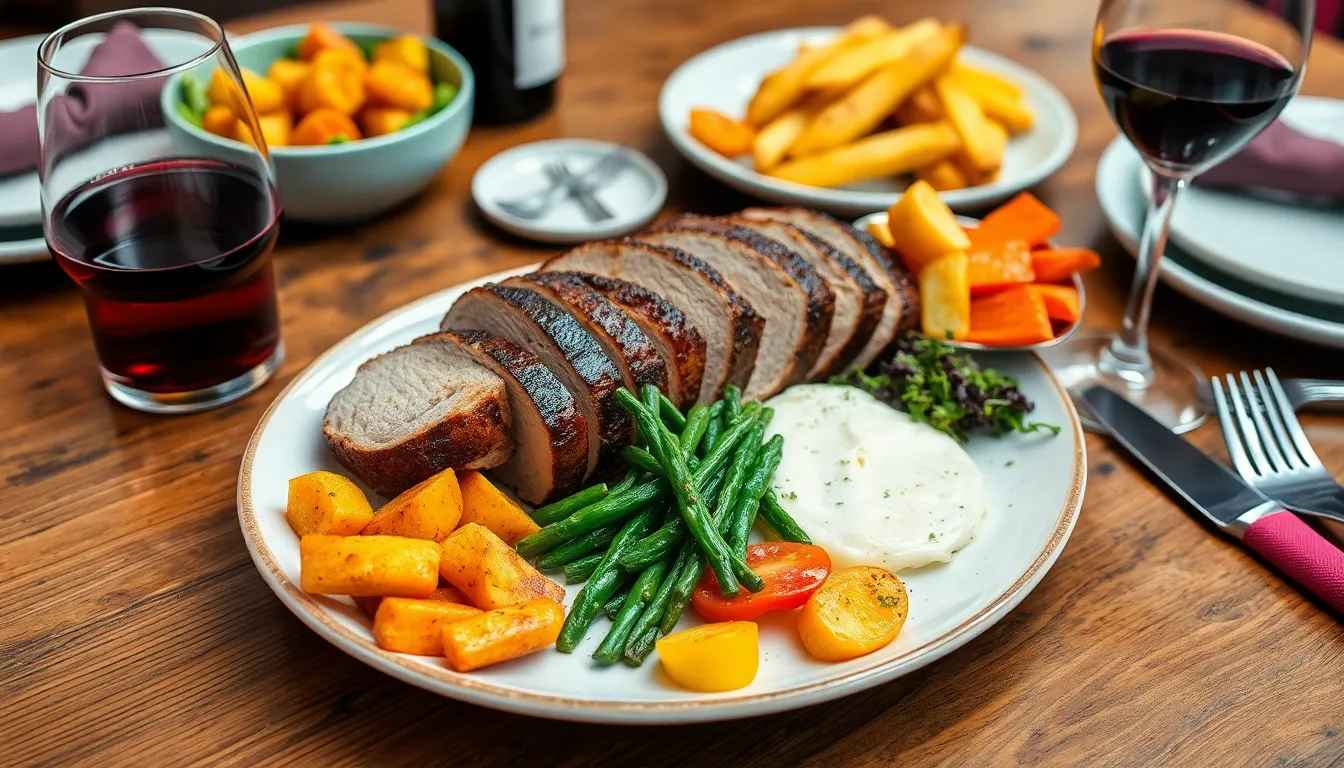
Your Spanish pork loin deserves to be paired with sides that complement its robust smoky-paprika flavors and tender texture. These traditional accompaniments and wine selections will elevate your dish to create an authentic Spanish dining experience.
Traditional Spanish Side Dishes
Patatas Bravas makes an excellent companion to Spanish pork loin with its crispy fried potatoes topped with spicy tomato sauce providing textural contrast to the tender meat. Spanish Rice cooked with saffron and vegetables adds a fragrant base that soaks up the juices from the pork. For a vegetable-forward option Pisto (Spanish ratatouille) combines tomatoes peppers zucchini and onions into a colorful medley that balances the richness of the pork.
Roasted potatoes drizzled with romesco sauce create a classic pairing that highlights traditional Spanish flavors. Garlic sautéed greens like spinach or kale provide a simple yet flavorful side that cuts through the richness of the meat. Mashed potatoes offer a comforting base for the flavorful pork while roasted vegetables such as curried cauliflower or spicy roasted veggies add dimension to your plate.
For a delightful contrast consider serving your pork loin with fried apples cooked in butter and brown sugar which creates an irresistible sweet and savory combination. The bright flavors of citrus also work wonderfully with this dish try incorporating oranges and lemons when roasting your pork for an aromatic twist.
Wine Pairings
Tempranillo stands as the quintessential Spanish red wine pairing for pork loin with its medium body and earthy cherry flavors complementing the smokiness and spice in the dish. Garnacha (also known as Grenache) offers a fruit-forward profile with soft tannins that harmonize beautifully with roasted pork and paprika-based seasonings.
For those who prefer white wine Albariño provides a crisp acidity that can balance the richness of the pork while improving any citrus notes in your preparation. Rioja reds featuring aged Tempranillo grapes bring complex notes that stand up admirably to the robust flavors of Spanish pork loin especially when served with traditional sauces.
The ideal wine should highlight the balance between the pork’s smoky savory profile and the bright vibrant flavors of your chosen side dishes creating a complete and satisfying meal experience.
Storage and Reheating Tips
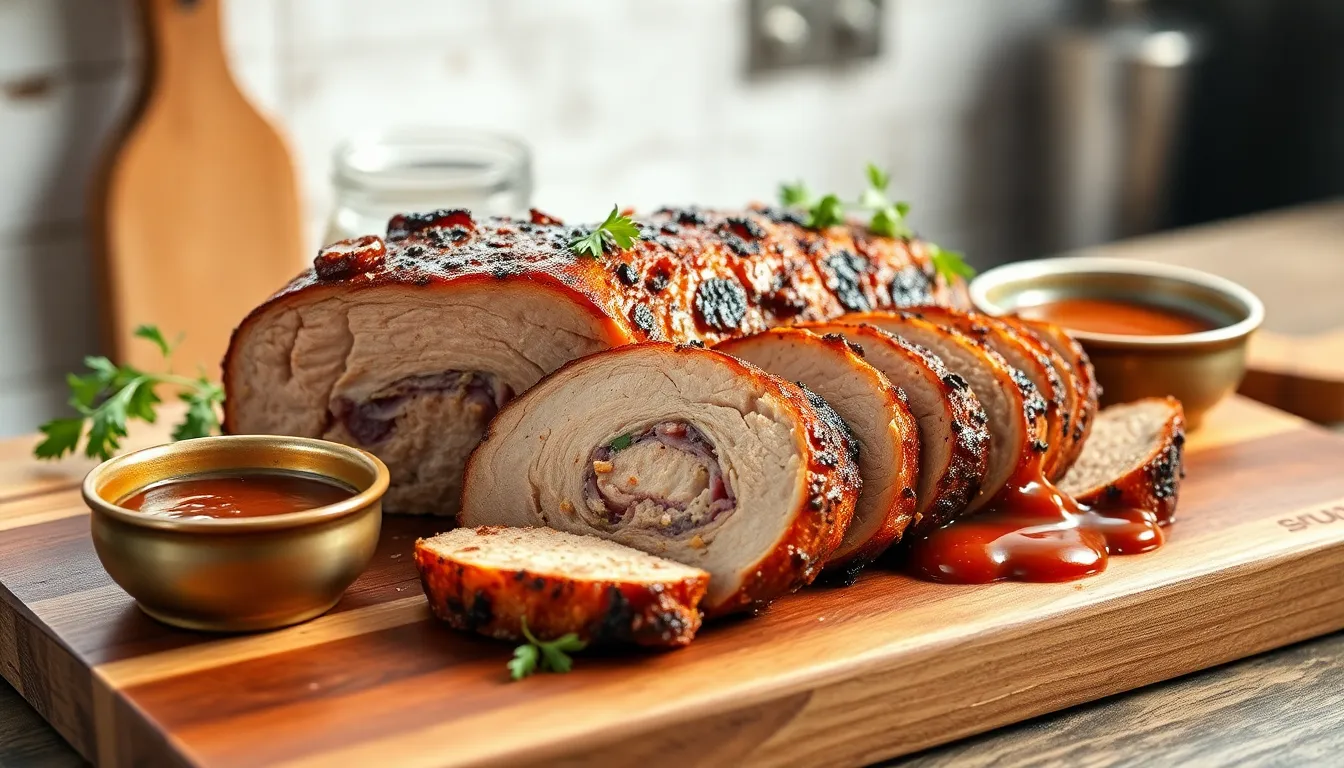
Proper storage and reheating techniques are essential for maintaining the quality and safety of your Spanish pork loin. Following these guidelines ensures you can enjoy your delicious dish for days after preparation.
Refrigerating Fresh Pork Loin
Store fresh Spanish pork loin in the coldest part of your refrigerator immediately after purchase. Keep the temperature below 40°F to prevent bacterial growth. Whole cuts of fresh pork can remain in their original packaging for up to 4-5 days in the refrigerator. Ground pork should be used within 2 days for optimal freshness and safety.
For cured Spanish pork loin (lomo curado), wash it with vinegar or wine to remove any surface molds before storage. Vacuum sealing provides the best protection and helps maintain proper moisture levels during controlled drying.
Storing Cooked Pork Loin
Place leftover cooked Spanish pork loin in airtight containers and refrigerate promptly after your meal. Consume refrigerated leftovers within 3-4 days for best quality and safety. When transporting your cooked pork loin to another location, use an insulated container or cooler to maintain safe temperatures.
Freezing for Longer Storage
For extended storage, wrap your Spanish pork loin tightly in heavy foil or freezer wrap. Alternatively, place it in a sealed freezer bag to prevent freezer burn and moisture loss. Frozen pork loin maintains optimal flavor for 2-3 months, though it remains safe to eat beyond this timeframe.
| Storage Method | Storage Time | Required Temperature |
|---|---|---|
| Fresh (refrigerated) | 4-5 days | Below 40°F |
| Ground pork (refrigerated) | 2 days | Below 40°F |
| Cooked (refrigerated) | 3-4 days | At or below 40°F |
| Frozen (raw or cooked) | 2-3 months for best quality | 0°F or below |
Reheating Spanish Pork Loin
When reheating your Spanish pork loin, heat it to an internal temperature of 165°F to ensure food safety. The oven provides the best method for reheating this dish without drying out the meat. Preheat your oven to 300°F and place the pork loin in a covered dish with a small amount of broth or water to maintain moisture.
Monitor the temperature carefully as overcooking can quickly dry out this lean cut. Use a meat thermometer to verify the internal temperature has reached the safe threshold without exceeding it unnecessarily.
For sliced pork loin, consider a quick sear in a hot pan to refresh the exterior while gently warming the interior. This method helps preserve the smoky paprika crust that makes Spanish pork loin so distinctive.
Spanish Pork Loin Variations

Spanish pork loin recipes showcase regional diversity and culinary creativity across Spain. These variations highlight different seasoning profiles while maintaining the essence of traditional Spanish cooking techniques.
Spicy Paprika Version (Lomo Adobado)
This traditional Basque preparation transforms an ordinary pork loin into a flavor-packed centerpiece with minimal ingredients. Select a pork loin with some fat cap to ensure the meat remains juicy throughout the cooking process. Coat your pork thoroughly with a robust mixture of sweet and hot paprika, fresh minced garlic, and kosher salt. The paprika blend infuses the meat with a distinctive smoky flavor and balanced heat that penetrates deeply into the pork.
You can prepare this dish through two main methods. Roast the whole seasoned pork loin for a stunning presentation at the dinner table. Alternatively, slice the loin into thick chops before cooking them in a skillet, following the common practice in Basque cuisine. Both approaches yield tender meat with the characteristic robust paprika aroma that defines this regional specialty. The straightforward technique makes lomo adobado accessible even to those new to Spanish cooking while delivering authentic flavors.
Herb-Crusted Alternative
This Mediterranean-inspired variation offers a fresher flavor profile that contrasts beautifully with the smokiness of the paprika version. Start by seasoning your pork loin or tenderloin generously with a vibrant herb mixture. Traditional Spanish herb combinations include garlic, coriander, and regional spices that create an aromatic crust around the meat.
Begin cooking by searing the herb-coated pork in a hot cast iron skillet to lock in flavors and create a textured exterior. Transfer the meat to the oven to finish cooking through. Many Spanish recipes incorporate citrus elements such as orange and lemon slices arranged around the pork during roasting. These citrus additions serve dual purposes—they maintain moisture within the meat while infusing it with bright, zesty notes that complement the herb coating.
Serve your herb-crusted pork loin with traditional accompaniments like piquillo pepper or romesco sauce to add another dimension of flavor. This versatile preparation works equally well for casual family dinners or special gatherings, demonstrating the Spanish culinary principle of creating sophisticated flavors through simple, quality ingredients.
Nutritional Information
Understanding the nutritional profile of Spanish pork loin helps you make informed dietary choices while enjoying this flavorful Mediterranean dish. Traditional Spanish pork loin preparations offer excellent protein content with varying fat levels depending on the exact cut and cooking method.
A typical serving of Spanish pork loin a la plancha (about 238 grams) provides approximately 576 calories and an impressive 64 grams of protein. This preparation contains around 33 grams of fat with 12 grams being saturated fat. The dish contains virtually no carbohydrates while offering important amounts of essential minerals including potassium (1007 mg), iron (2.1 mg), and calcium (45 mg).
The traditional Iberico pork loin, prized for its rich marbling and distinctive nutty flavor, contains similar nutritional values. A 240-gram serving delivers approximately 555 calories with 58 grams of protein and 35 grams of fat. The acorn diet of Iberico pigs contributes to heart-healthy fat content that distinguishes this premium variety from standard pork cuts.
For those seeking a leaner option, Spanish-style roast pork prepared similar to Pollo Tropical contains fewer calories (278 per serving) while still providing substantial protein (29 grams). This preparation maintains a balanced nutritional profile with 16 grams of fat and minimal carbohydrates.
| Preparation Style | Serving Size | Calories | Protein | Fat | Carbohydrates | Key Minerals |
|---|---|---|---|---|---|---|
| Pork Loin A La Plancha | 238g | 576 | 64g | 33g | 0g | Potassium: 1007mg, Iron: 2.1mg, Calcium: 45mg |
| Iberico Pork Loin Grilled | 240g | 555 | 58g | 35g | 0g | Potassium: 817mg, Iron: 2.6mg, Calcium: 26mg |
| Spanish Roast Pork | 1 serving | 278 | 29g | 16g | 2g | Sodium: 465mg |
| Spanish Inspired Pork Loin Steaks | 1 steak | 288 | – | 17g | 6g | – |
The Mediterranean seasonings commonly used in Spanish pork loin recipes—olive oil, garlic, rosemary, and paprika—add minimal calories while contributing beneficial compounds. Olive oil provides heart-healthy monounsaturated fats, while herbs and spices add antioxidants and anti-inflammatory properties without significantly impacting the overall calorie content.
Spanish pork loin fits well into balanced diet plans focused on quality protein sources. The negligible carbohydrate content makes this dish suitable for low-carb and ketogenic diets, while the substantial protein content supports muscle maintenance and growth. When consumed in appropriate portions, Spanish pork loin offers a satisfying meal option that aligns with nutritionally balanced eating patterns.
Final Thoughts on Spanish Pork Loin
Spanish pork loin stands as a testament to the beauty of simplicity in Mediterranean cooking. With just a handful of quality ingredients and basic techniques you can create a dish that’s both impressive and authentic.
Whether you choose the smoky paprika-forward lomo adobado or the aromatic herb-crusted variation you’ll appreciate how this versatile cut adapts to various cooking methods. Its lean yet flavorful profile makes it perfect for both casual family dinners and elegant entertaining.
The true magic of Spanish pork loin lies in its balance – tender meat with a flavorful crust distinctive seasonings that enhance without overwhelming and preparation methods that honor tradition while fitting modern lifestyles. Try this Spanish culinary treasure and discover why it has remained a beloved classic across generations.
Frequently Asked Questions
What is Spanish pork loin (lomo de cerdo)?
Spanish pork loin is a traditional dish featuring tender pork cuts marinated in olive oil, garlic, paprika, and herbs. Unlike American versions that often use sweet glazes, Spanish pork loin embraces Mediterranean flavors with smoky-savory profiles. It’s a cornerstone of Spanish cuisine that can be enjoyed warm as a main course or cold as part of a tapas spread.
What makes Spanish pork loin different from other pork recipes?
Spanish pork loin stands out for its distinctive Mediterranean flavor profile using paprika, garlic, and olive oil rather than sweet glazes common in American recipes. The cooking technique involves searing before slow roasting, ensuring a juicy interior with a flavorful crust. Regional variations exist throughout Spain, with Andalusian versions using more paprika while Catalonian preparations incorporate more garlic and herbs.
What cuts of pork are best for this recipe?
Center-cut pork loin with a good fat cap is ideal for Spanish pork loin recipes. The fat helps retain moisture and enhances flavor during cooking. If you prefer a leaner, quicker-cooking option, pork tenderloin can be substituted, though cooking times will need to be adjusted. Quality meat selection significantly impacts the final result of this traditional dish.
How long should I marinate Spanish pork loin?
For optimal flavor development, marinate Spanish pork loin for at least 6 hours, though 24 hours is ideal. This lengthy marination allows the paprika, garlic, olive oil, and herbs to deeply penetrate the meat, enhancing both flavor and tenderness. Before cooking, allow the marinated meat to reach room temperature for about 30 minutes to ensure even cooking.
What are the essential spices for authentic Spanish pork loin?
Authentic Spanish pork loin requires both sweet and smoked paprika (pimentón), fresh garlic, kosher salt, and olive oil as foundation ingredients. Additional spices often include ground coriander, cumin, oregano, and crushed red pepper flakes. The combination creates the distinctive smoky-savory profile that defines this traditional Spanish dish. High-quality spices will yield the best results.
What cooking methods work best for Spanish pork loin?
Spanish pork loin is versatile and can be prepared using several cooking methods. Oven-roasting at 300°F (150°C) develops deep flavors, while grilling adds appealing smokiness. Pan-frying thick slices is common in Basque cooking for quicker meals. Slow cooker preparation yields extremely tender results. Each method showcases the robust Mediterranean flavors in different ways.
What should I serve with Spanish pork loin?
Traditional accompaniments include Patatas Bravas (crispy potatoes with spicy sauce), Spanish rice, or Pisto (Spanish ratatouille). Roasted potatoes with romesco sauce, garlic-sautéed greens, or fried apples also complement the pork beautifully. For wines, pair with Tempranillo or Garnacha (red) or Albariño (white) to balance the meat’s smoky profile.
How do I store and reheat leftover Spanish pork loin?
Store cooked Spanish pork loin in airtight containers in the refrigerator for 3-4 days. For longer storage, wrap tightly and freeze for up to 3 months. When reheating, use an oven at 325°F with a splash of liquid to maintain moisture until the internal temperature reaches 165°F. Alternatively, quickly sear sliced pork in a hot pan to refresh its flavor and texture.
Is Spanish pork loin healthy?
Spanish pork loin is relatively healthy, providing approximately 64 grams of protein per typical serving with moderate fat content. The Mediterranean seasonings add beneficial compounds with minimal calories. This dish fits well into balanced diets, including low-carb and ketogenic plans. The lean protein supports muscle maintenance while the preparation method keeps it flavorful without excessive added fats.
What are some regional variations of Spanish pork loin?
Regional variations include lomo adobado (featuring a robust paprika marinade popular throughout central Spain), herb-crusted versions from northern regions using rosemary and thyme, and citrus-infused preparations common in coastal areas. Andalusian recipes use more paprika, while Catalonian versions incorporate more garlic and herbs. Each regional approach highlights local ingredients while maintaining the dish’s essential Spanish character.
